The Dwarf gourami is a small, brightly colored tropical fish that brings color and interest to a peaceful community fish tank. These labyrinth fish are beginner-friendly and relatively hardy, too.
So, are Dwarf gouramis hard to keep? How big do Dwarf gouramis get? And what are the best tank mates for Dwarf gouramis?
Read this comprehensive guide to learn everything you need to know about Dwarf gourami care, diet, diseases, and breeding these gorgeous fish.
Dwarf Gourami – At A Glance
Scientific Name
Trichogaster lalius
Common Name (species)
Dwarf gourami, Dwarf Banded gourami, Red lalia,
Family
Osphronemidae
Origin
India, Pakistan, Bangladesh, the U.S., Singapore, Colombia
Diet
Omnivore
Care Level
Beginner-friendly
Activity
Active
Lifespan
Annual in nature, but 2 to 5 years in captivity
Temperament
Peaceful, somewhat shy
Tank Level
Mainly the middle and top of the water column
Minimum Tank Size
10 gallons
Temperature Range
72° to 82° F
Water Hardness
5 – 18 dGH
pH Range
6.0 to 8.0
Filtration/Flow Rate
Well-filtered water and moderate to low flow rate
Water type
Freshwater
Breeding
Egg-layer that can be bred in a home tank
Compatibility
Peaceful community fish
OK, for Planted Tanks?
Yes
Dwarf Gourami Origins
Dwarf gouramis come from South Asia, ranging from Bangladesh, Pakistan, and India, having first been described by Hamilton in 1822. Today, there are a few feral populations of Dwarf gouramis in the U.S., Singapore, and Colombia.
The specimens you find for sale in fish stores are commercially reared, and many hobbyists successfully raise Dwarf gouramis in their home fish tanks.
Natural Habitat
Dwarf gouramis inhabit slow-moving waters, such as paddy fields, irrigation channels, streams, and the like, where the water is clogged with thick vegetation.
These fish are omnivores, eating algae, small invertebrates, and insects. Interestingly, Dwarf gouramis are ambush hunters, squirting water jets from their mouths to knock their prey off low-hanging branches and into the water, where the fish lay in wait.
Dwarf Gourami Appearance
Dwarf gouramis have compressed bodies and large, rounded fins. The distinctive ventral fins resemble trailing threads and bear touch-sensitive cells, which the fish use to find their way around their dimly lit habitat.
Male fish are a gorgeous, vibrant blue-green shade with reddish-orange vertical stripes. When spawning, males become deep purple on their breasts and flare their dorsal fins in a courtship ritual.
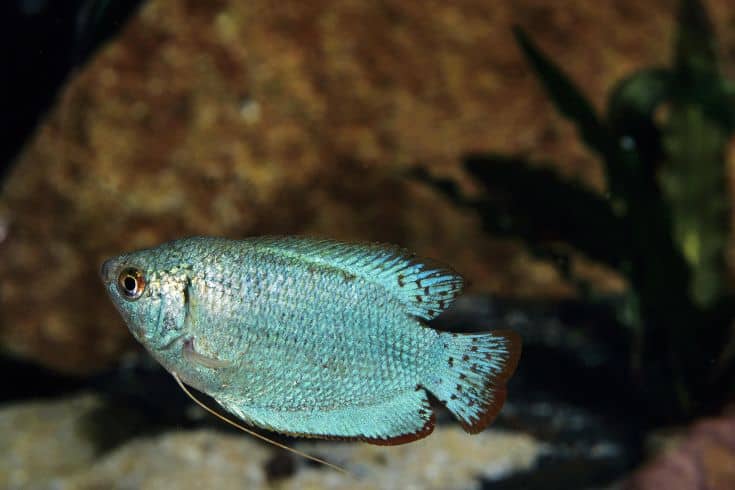
The female fish are less colorful, with silvery-gray bodies that lack the vivid red stripes of the males.
Species Variants
Selective breeding of Dwarf gouramis has produced several color morphs, including the Powder Blue Dwarf gourami, which is bright blue, and the Flame Dwarf gourami, which boasts a deep orange-colored chest and belly. There are also Neon Blue Dwarf gouramis that are adorned with vibrant blue and dark crimson stripes.
How Big Will Dwarf Gouramis Get?
Dwarf gouramis typically grow to around 2 to 3 inches long, with male fish being slightly bigger than females. So, you can keep these fish in a small 10-gallon aquarium.
Dwarf Gourami Lifespan
Wild Dwarf gouramis are annual fish. However, in captivity, the fish can survive for up to four years if you keep them in a clean freshwater tank with the correct water chemistry and offer your pets a balanced, nutritious diet.
Activity Level and Behavior
The Dwarf gourami is a peaceful character that makes a great candidate for a community aquarium.
However, these fish are quite timid and shy, so you need to choose similar-natured tank mates for them. Be careful where you put your fish tank, as the gouramis can be pretty nervous if kept in busy rooms with lots of noise and foot traffic.
Sometimes, male gouramis can be mildly aggressive toward each other and can sometimes bully females. For that reason, we recommend keeping a group of these fish in a large fish tank, where individuals have plenty of space to retreat to when they want some alone time.
What Are The Best Tankmates For Dwarf Gouramis?
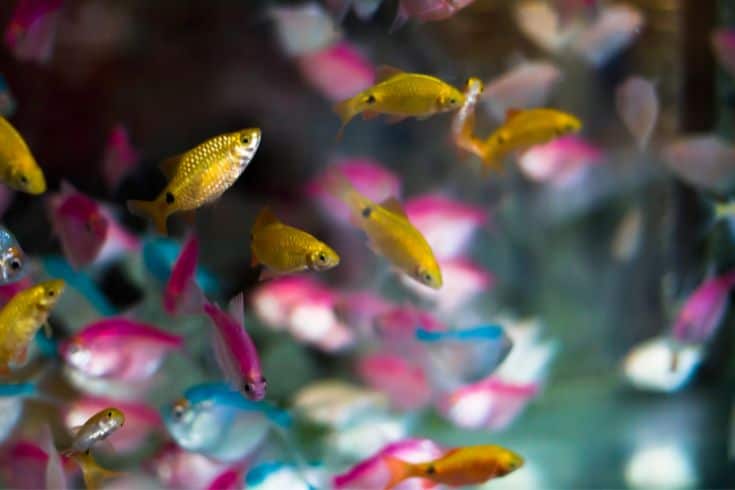
There are lots of small, peaceful fish that are ideal tank mates for Dwarf gouramis, including the following:
- Swordtails
- Mollies
- Corydoras catfish
- Loaches
- Rasboras
You can also keep other peaceful species of gouramis, such as Honey gouramis, with the Dwarf variety.
Fish Species to Avoid
Large, semi-aggressive fish are not suitable tank mates for the shy Dwarf gourami.
In addition, nippy fish, including some barb and tetra species, should be avoided. Brightly colored fish, such as Fancy guppies, can trigger aggression in Dwarf gouramis, as can other gourami species and bettas.
How Many Dwarf Gouramis Should Be Kept Together?
In fish stores, Dwarf gouramis are frequently sold in pairs. However, males will sometimes bully their female companions. In addition, like betta fish, male Dwarf gouramis are often belligerent toward each other, especially if you have a small aquarium.
Dwarf gouramis like to school together and can be kept in large groups of five or more, provided you have sufficient space in your tank. Generally, I’ve always found that the more fish you have in the group, the less likely it is that they’ll fight.
Diet and Nutrition
When choosing food for your Dwarf gouramis, always buy the best quality food that you can afford. A high-quality, balanced diet will keep your fish healthy and bring out their best colors.
What Do Dwarf Gouramis Eat?
Dwarf gouramis are omnivorous fish that eat meaty protein and vegetable matter.
A good diet for gouramis can include tropical fish flakes, pellets, frozen brine shrimp, bloodworms, and the like.
Should I Give My Gouramis Live Food?
Although Dwarf gouramis enjoy live foods, we recommend you don’t go down that route.
Unfortunately, many live foods sold in pet stores come with a cargo of parasites and bacteria that can harm your fish. For the same reason, don’t be tempted to collect live foods from the wild environment.
If you’re keen to give your fish live food, you might want to consider setting up a home brine shrimp hatchery.
How Much and How Often Should You Feed Your Dwarf Gouramis?
Ideally, Dwarf gouramis can be fed two or three times each day.
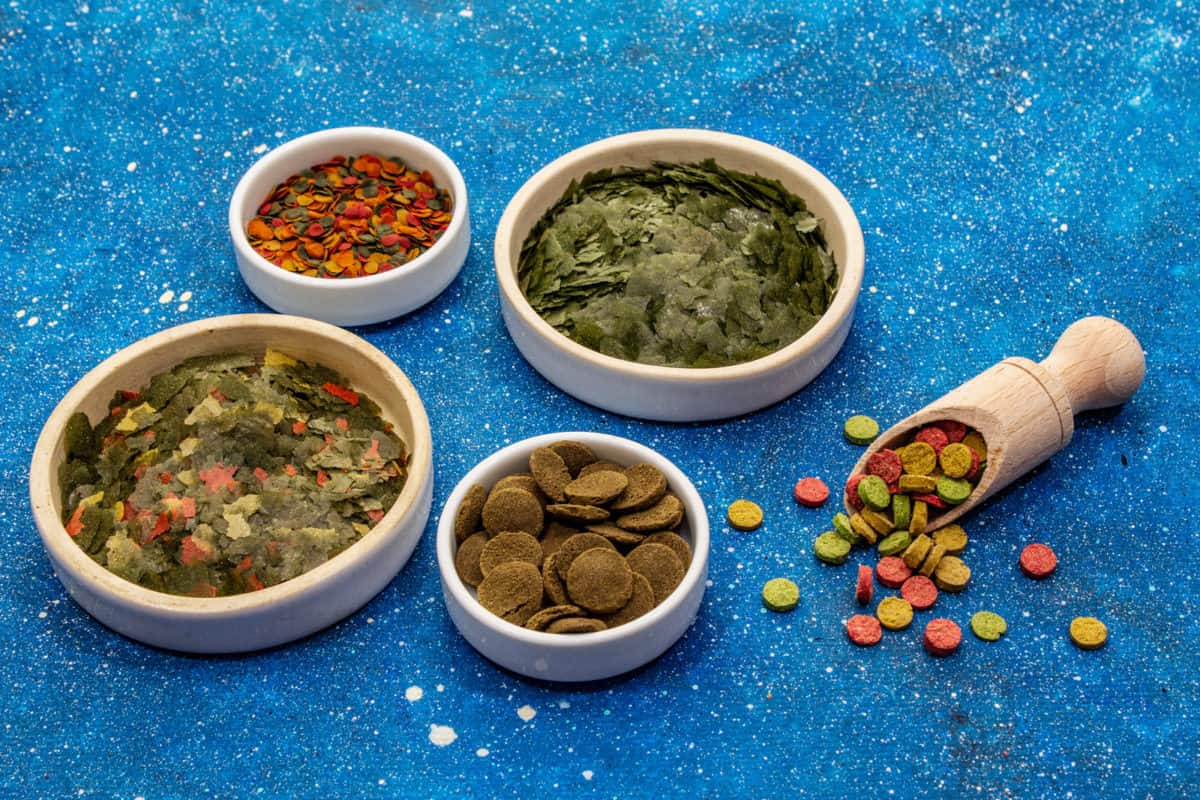
To avoid overfeeding your fish, you should offer your gouramis only what they will eat in a couple of minutes. Overfeeding leads to health problems and increases waste, which will increase the bioload on your filtration system.
Tank Setup
Tank size
A few Dwarf gouramis can be kept in a 10-gallon tank. However, if you want to keep a large group of these beautiful fish or set up a community of different species, you’ll need a bigger aquarium.
Dwarf gouramis are labyrinth breathers, so they need to visit the water’s surface regularly to grab gulps of air, and they’re also surface feeders. For that reason, a long tank is better for Dwarf gouramis than a tall one.
Rectangular tanks also provide more space for the fish to school together and facilitate better gaseous exchange, improving the dissolved oxygen levels in the tank.
You’ll need a lid or a cover slide for your aquarium since Dwarf gouramis will jump when alarmed, and you don’t want to find one of your pets on the floor!
Aquarium Setup
Substrate
Dwarf gouramis are fine with any kind of substrate. However, dark-colored gravel is the best choice to make their bright colors really pop.
Decoration
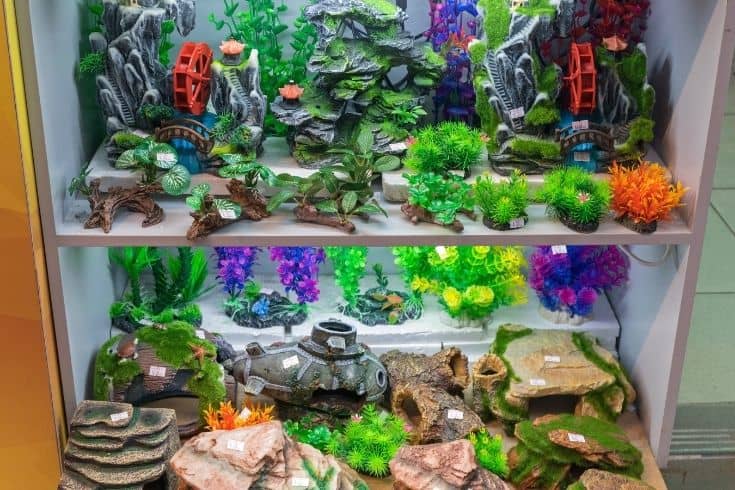
Dwarf gouramis are shy fish that prefer a well-decorated tank with plenty of hiding places where they can take refuge if they want to. So, use driftwood, tangled roots, and imaginative rockwork in your aquarium.
Plants
In their wild home, these fish live in densely vegetated, dimly lit water bodies, and you can recreate that by using species with a thick, bushy habit. Floating plants are a good choice because they offer somewhere for the fish to build bubble nests, as well as provide dappled shade.
Habitat Requirements
Dwarf gouramis are generally hardy fish. However, they do appreciate a well-maintained, clean tank with water that’s free from pollutants, such as ammonia, nitrites, and nitrates.
Filtration
Your aquarium should have an efficient biological and mechanical filter, and you can include a chemical filtration element, too if you want to. Gouramis live in water with relatively little movement, so you might need to buffer the flow from your pump or choose an external system, such as a HOB or canister system.
Water Parameters
Water Temperature
Dwarf gouramis prefer a warm water temperature of between 72° and 82° F, ideally close to 77°.
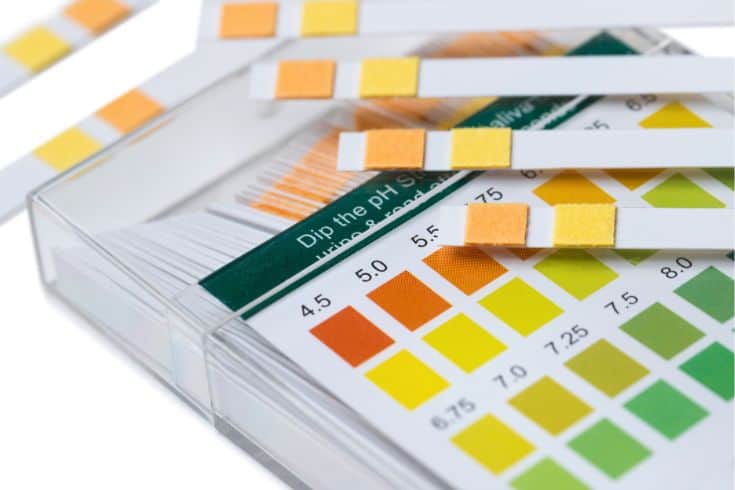
NB: If possible, keep the ambient room temperature the same as that of the tank water to avoid damaging the gourami’s sensitive labyrinth organ.
Water Hardness and pH Range
The water pH should be between 6.0 and 8.0, with a water hardness of 5 to 18 dGH.
Lighting
Gouramis prefer a reasonably well-lit environment with shade provided by plants and decorations. Regular aquarium lighting is fine for these fish and for most beginner-friendly aquarium plants, too.
Tank Maintenance
To keep the gourami’s aquarium in good health, you need to perform 25% to 30% weekly water changes, remembering to vacuum the tank bottom to remove fish waste, organic debris, and uneaten fish food.
I like to remove the filter media from the unit every two weeks or so and rinse it in dirty tank water to get rid of sludge and clogs that would stop the water from flowing through the unit.
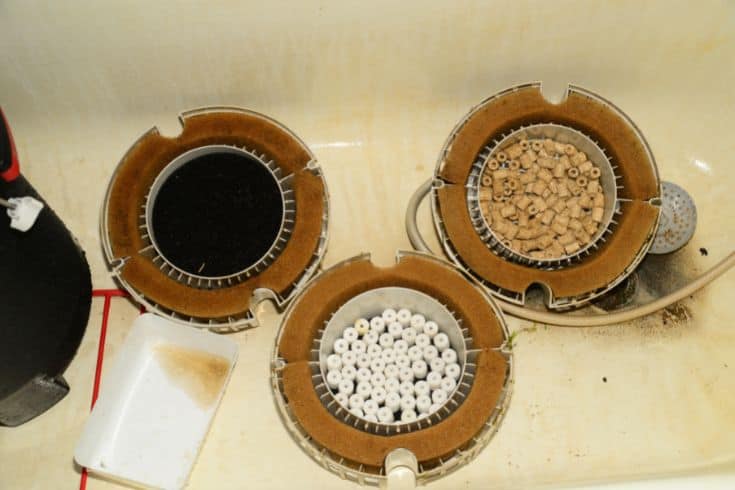
Clean algae from the viewing panes with an algae scraper or magnet.
Setting Up Your Fish Tank
Assemble all the kit you need to set up your new tank, including the following items:
- Dark-colored substrate
- LED lighting unit
- HOB or canister filtration system
- Water conditioner
- Heater
- Aquarium thermometer
- Tank decorations
- Aquatic plants
- Aquarium water testing kit
Setting Up Your Aquarium – A Step-By-Step Guide
- Clean the gravel under running water.
- Put two to three inches of the substrate into the tank.
- Add the filter and heater to the tank but don’t turn them on yet.
- Add dechlorinated water to just below the aquarium’s fill line. I always pour the water over a large stone so that the gravel doesn’t scatter everywhere.
- To begin the nitrogen cycle, add a few drops of pure ammonia, some substrate from a healthy, mature tank, or a pinch of fish food.
- Wash your decorations and add them to the tank.
- Remove dead leaves and damaged stems from your plants and add the plants to your setup, leaving room for growth.
- Turn on the filtration unit and heater. Your plants need eight to ten hours of daily light for photosynthesis, so set a timer if you won’t be around to turn the lights off and on manually.
Leave the tank to fully cycle before you add your livestock. That process can take from ten days to four weeks, although you can speed things up by adding biological supplements that boost the growth of beneficial nitrifying bacteria.
Test the water daily using an aquarium water testing kit. When ammonia and nitrate levels are zero and nitrates are below 20 ppm, you know that the nitrogen cycle is complete, and you can add a few small fish to the aquarium.
Health and Disease
Dwarf gouramis are generally pretty hardy fish, although they can fall foul of a few common fish diseases.

Signs of Good Health
Dwarf gouramis are active fish that shoal together in the middle to the upper water column, visiting the water surface every so often to grab gulps of air.
Red Flags
These red flags might indicate health problems for your gouramis:
- No eating
- Inactivity
- Not breathing at the water’s surface
- Sore, red patches on the body
- Rubbing against solid objects in the tank
- Hanging at the water’s surface
Dwarf Gourami Diseases and Prevention
Health Issue
Ich (White Spot Disease)
Symptoms or Causes
Ich is a very common disease that’s caused by an aquatic protozoan parasite.
Fish infected with Ich develop a sprinkling of tiny white spots on their fins, gill covers, and bodies. They also flash against the gravel and other solid objects in the aquarium.
Suggested Action
Raise the water temperature to 82o F for three days. Use an OTC White Spot Disease medication to treat the tank.
Health Issue
Flukes
Symptoms or Causes
Flukes is the term used to describe various types of external fish parasites. These macroparasites can often be seen with the naked eye attached to the fish’s skin or gills.
Suggested Action
Treat the fish tank with an OTC antiparasitic medication.
Health Issue
Fungal infections
Symptoms or Causes
White fluffy growths on the fish’s body, mouth, and head.
Suggested Action
Quarantine infected fish, and treat with an antifungal medication.
Health Issue
Bacterial infections
Symptoms or Causes
Sores and ulcers on the body and head, ragged, bloody fins.
Suggested Action
Treat the tank with OTC antibacterial treatment.
Breeding
You can breed Dwarf gouramis relatively easily in the home tank. However, males are often aggressive toward females, especially once spawning is complete.
Male gouramis build a bubble nest, picking up the eggs from the substrate where the female deposits them and moving them to the nest before guarding the eggs until they hatch. The fry stays around the bubble nest for a few days until they’ve eaten the egg sac, when the babies become free-swimming.
At this stage, you should remove the male before he has a chance to eat the fry.
Availability
You can buy all the color variants of Dwarf gourami in fish stores and online, typically for a few dollars per fish.
Product Recommendations
- Water dechlorinator
- Algae magnet or scraper
- Aquarium thermometer
- Aquarium vacuum
- Tropical fishkeeping books
- HOB or canister filter
- Fish tank (minimum size 10 gallons)
- Heater
- High-quality tropical fish flake, pellets, and frozen food
- LED lighting unit
- Selection of live aquatic plants
- Tank decorations
- Dark substrate
- Aquarium water testing kit
Final Thoughts
Did you enjoy our guide to gorgeous Dwarf gouramis and how to care for them? If you found the information helpful, remember that sharing is caring!
Dwarf gouramis come in several color morphs and make a beautiful addition to any peaceful community tank. For a fun project, why not have a go at breeding these delightful fish yourself? Male gouramis can be aggressive toward each other and with females, so it’s best to keep large groups of these fish in a spacious tank with plenty of cover.
Did you successfully breed dwarf gouramis? Tell us in the comments box below.
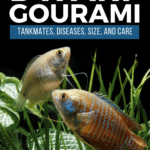
My Dwarf Gourami has a hole in top fin looks like he has been bitten treated with salt and melafix will it grow back he is eating ok
Thank you so much for helping me understand better on how to take care of my Dwarf Gourami Charlie.